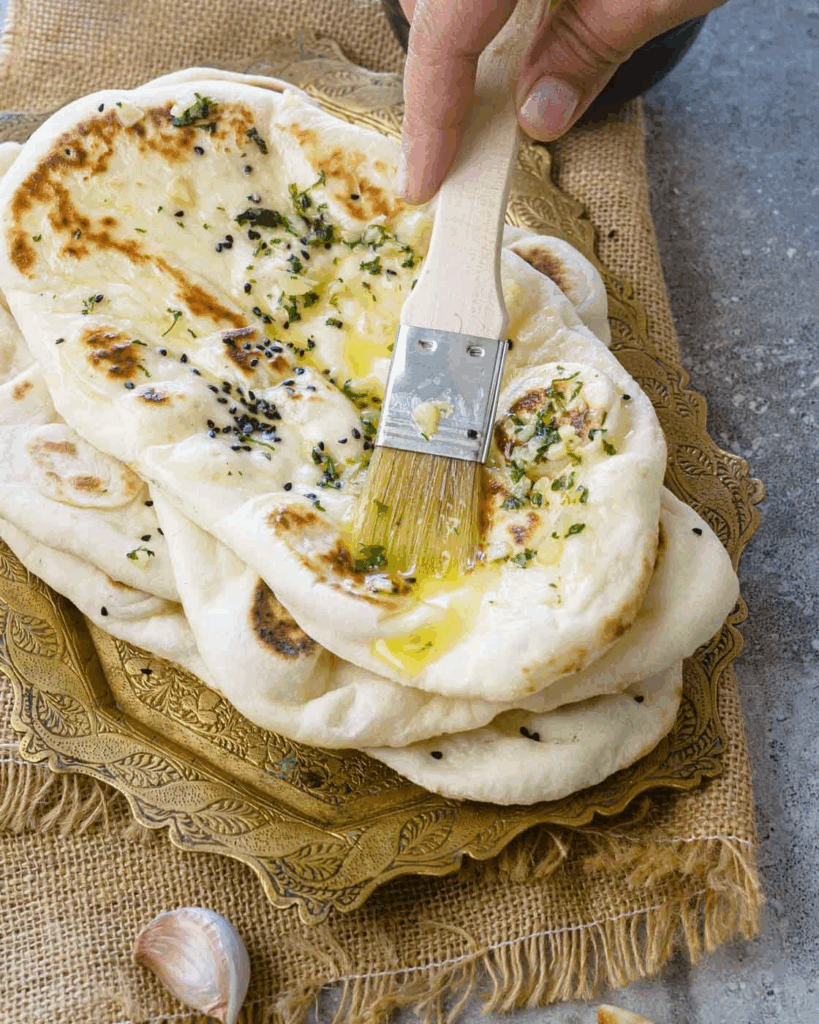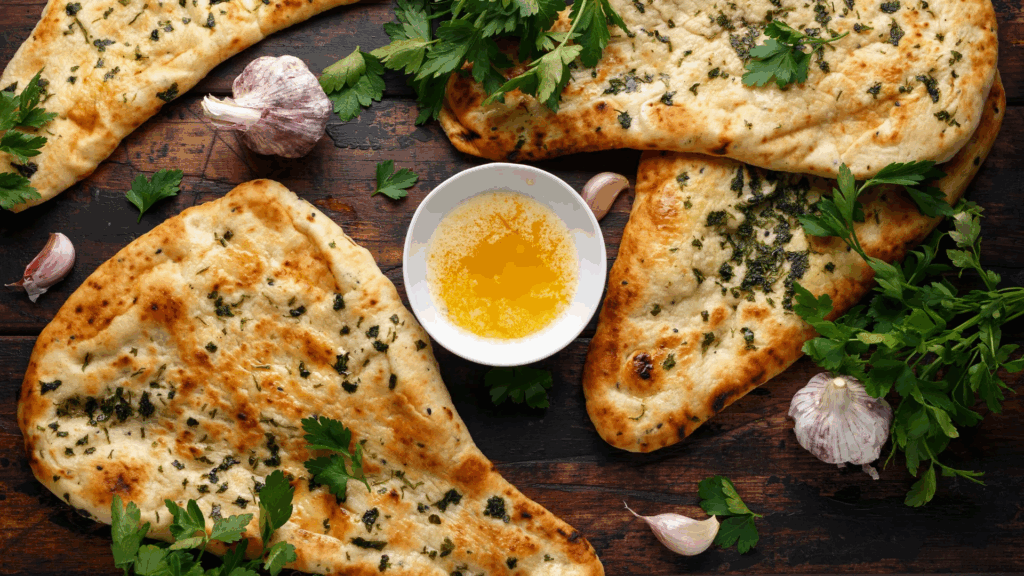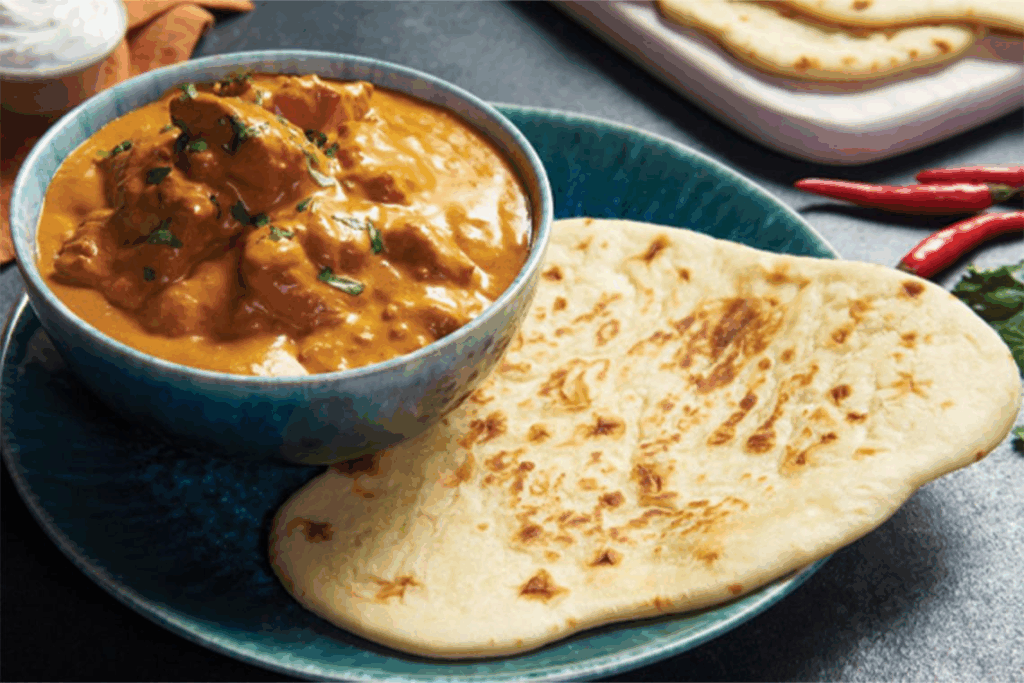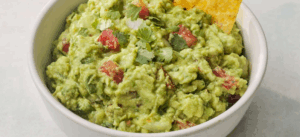Recipe for Indian Butter Naan at Home

I still remember the aroma when I first pulled hot, buttery naan from a tandoor in Delhi—it was life-changing. Since then, making naan at home has been part of my kitchen ritual. It’s simple in concept but magical in execution: a soft, pillowy flatbread brushed with melted butter, perfect for mopping up curries or serving solo. In this guide, I’ll share every detail I’ve learned—from dough texture and resting times to creative cooking methods like oven, skillet, and even microwave.
- Why Butter Naan Stands Out in Indian Cuisine
- Essential Ingredients for Perfect Homemade Naan
- Timing Table for Naan Dough and Cooking
- Preparing Naan Dough: Kneading and Proofing Techniques
- Cooking Naan on a Stovetop or Skillet
- Baking Butter Naan in the Oven
- Making Naan in the Microwave or Air Fryer
- Flavor Variations: Garlic, Cheese, Stuffed Naan Ideas
- Serving Butter Naan with Indian Dishes
- Best Ingredients for Authentic Texture
- Cooking Time and Preparation Table
- Making Naan Dough in Advance
- Using Microwave, Oven, and Slow Cooker for Naan
- Healthier Alternatives and Whole Wheat Naan
- Pairing Butter Naan with Drinks and Sweets
- Storing Leftovers and Reheating
- FAQ (Frequently Asked Questions)

Why Butter Naan Stands Out in Indian Cuisine
Butter naan isn’t just bread—it’s a canvas for flavor. Whether alongside rich dishes or enjoyed on its own, its soft texture and golden buttery finish make it irresistible. In restaurants, naan is the star that pulls every curry together. At home, I’ve served it with everything from spicy Pav Bhaji to exotic Middle‑Eastern dips. Its popularity comes from its adaptability and comforting simplicity.
Essential Ingredients for Perfect Homemade Naan
Creating naan is about balance and quality. I always use:
- All-purpose flour for softness, sometimes blended with a little whole wheat for texture.
- Active dry yeast for lift, or yogurt for a milder, quicker fermentation.
- Warm water and a teaspoon of sugar, to activate the yeast.
- Salt and a pinch of baking powder, for flavor and fluff.
- Oil or ghee in the dough for tenderness, and plenty of melted butter for brushing.
From my experience, using high-protein flour helps naan rise well. I’ve also experimented with adding garlic, nigella seeds, or cilantro after kneading—those extras make homemade naan feel gourmet.
Timing Table for Naan Dough and Cooking
| Task | Active Time | Rest/Proof Time | Notes |
| Mixing dough | 10 min | – | Includes kneading until smooth |
| First rest/proof | – | 1–2 hours | Dough doubles in size |
| Dividing & shaping naans | 10 min | – | Shape into rounds or teardrops |
| Second rest (optional) | – | 15 min | Helps soften texture |
| Cooking (per naan) | ~3 min | – | On skillet, oven, or stovetop |
| Total active time | ~25–30 min | ~1–2 hours | Most time is passive |
I often multitask: while naan proofs, I prepare dishes like Pani Puri or Masala Dosa (вставить ссылки на Indian street food: how to make Pani Puri и What is Masala Dosa and why it’s so popular). This kitchen rhythm keeps dinner efficient and fun.
Preparing Naan Dough: Kneading and Proofing Techniques
The magic of homemade naan begins with the dough. I measure ingredients precisely and knead until the dough is smooth yet slightly tacky. It shouldn’t stick to your fingers, but will bounce gently when pressed. After a quick oil rub, I let it proof in a warm corner—sometimes I place it near a warm oven or wrap it in a towel.
That first rest is crucial for flavor development and texture. I’ve even tried using yogurt instead of yeast for a traditional shortcut—I’ve tried and can recommend it for slightly softer, tangier results. Once doubled in size, I deflate the dough gently and divide it into equal portions. At this point I let them rest again briefly, allowing gluten to relax—this gives the naan its final fluffiness.

Cooking Naan on a Stovetop or Skillet
When I don’t have access to a tandoor, my go-to is a hot cast-iron skillet. I roll each dough ball into a teardrop or round shape, then toss it onto the dry, preheated pan. In seconds, bubbles begin forming. I press lightly with a spatula to help it puff.
After a minute or so, I flip it—and that’s when I see golden brown blisters forming. Just before removing, I brush it generously with butter or ghee. Sometimes, I’ll rub it with a garlic clove for extra depth. This method is perfect for quick dinners, especially with something hearty like Masala Dosa.
Baking Butter Naan in the Oven
Oven-baking naan brings a different charm—softer, fluffier, and ideal when making large batches. I preheat my oven to its highest setting (usually around 500°F / 260°C) and place a pizza stone or baking tray inside to mimic the tandoor’s heat.
Once hot, I place the rolled dough directly on the stone or tray and bake for about 2–3 minutes until the naan puffs up. A quick broil at the end adds those signature charred spots. Immediately after, I brush each naan with warm butter and sometimes a dash of sea salt. This method pairs beautifully with cooling drinks like Mango Lassi for a balanced meal.
Making Naan in the Microwave or Air Fryer
Microwaving naan isn’t traditional, but I’ve experimented with it when in a rush. You can par-cook the naan dough for 30–40 seconds to puff it up, then transfer it to a hot skillet or toaster oven to finish. It’s not ideal for texture, but for reheating naan, the microwave with a damp towel works great.
Air fryers, on the other hand, deliver surprising results. I set mine to 400°F (200°C), place the rolled naan inside, and cook for 2 minutes per side. It crisps faster, with nice color and rise. Great when you’re making naan just for yourself or one other person.

Flavor Variations: Garlic, Cheese, Stuffed Naan Ideas
Plain butter naan is just the beginning. I’ve made garlic naan by mixing minced garlic into the dough and sprinkling more on top before baking. Cheese naan is a favorite among kids—I fill it with grated mozzarella and press the edges closed like a calzone before cooking.
For a more filling version, I’ve stuffed naan with spiced mashed potatoes or paneer. Each version brings its own identity. These flavored naans work particularly well with street-style dishes like Pani Puri or Pav Bhaji when serving a full Indian food spread at home.
Serving Butter Naan with Indian Dishes
From my kitchen experience, butter naan is one of the most versatile breads to serve. I often pair it with rich gravies like butter chicken, paneer tikka masala, or even vegetarian options like chana masala. The buttery layer helps soak up the sauces beautifully, making each bite indulgent.
At home, I also serve it with dry sabzi (vegetable stir-fries), where the soft naan balances the spiced textures. For parties, I love offering it alongside small bowls of dal and raita, allowing everyone to tear and dip freely. Butter naan adapts to nearly every Indian meal style—from street food to formal feasts.
Best Ingredients for Authentic Texture
Through many trials, I’ve found a few ingredients make or break authentic naan:
- All-purpose flour (maida): Gives naan its soft, chewy base.
- Yogurt: Adds tang and tenderness, helping with fermentation.
- Ghee or butter: Needed for richness and that unmistakable aroma.
- Baking powder or yeast: For leavening—yeast gives a bolder rise and taste.
- Warm milk or water: Helps activate the yeast and keeps the dough soft.
I avoid over-kneading and let the dough rise in a warm place, covered with a moist cloth. When the dough doubles in size, you know you’re ready.

Cooking Time and Preparation Table
I’ve organized typical timing below based on experience in different home setups. Use this as a guide:
| Stage | Duration | Notes |
| Mixing and kneading dough | 10–15 minutes | Mix until smooth, slightly sticky |
| Dough resting/proofing | 1–2 hours | Let it double in size, covered |
| Dividing and rolling | 10–12 minutes | Roll gently; don’t flatten too thin |
| Cooking (stovetop/oven) | 2–3 minutes per naan | Adjust heat to avoid burning or undercooking |
| Butter brushing & serving | 1–2 minutes | Brush immediately after cooking for best absorption |
Making Naan Dough in Advance
As someone who often preps for busy weeknights or dinner guests, I can confidently say that making naan dough in advance is a true lifesaver. I usually knead the dough as usual, cover it tightly with plastic wrap, and refrigerate it for up to 48 hours. It continues to develop flavor and remains pliable. When I’m ready to cook, I remove it from the fridge about 30 minutes ahead to bring it back to room temperature—it rolls out more easily this way and cooks evenly.
Freezing is another method I rely on when planning large gatherings. I cook each naan partially—just enough to set the shape—then let them cool. Once cooled, I stack them with parchment paper between layers, seal in a freezer-safe bag, and store. When it’s time to serve, I reheat them straight on a hot skillet or in the oven. Brushing with fresh melted butter brings them back to life—crispy edges, soft center, and full of that signature aroma. Honestly, it’s almost indistinguishable from freshly made.
Using Microwave, Oven, and Slow Cooker for Naan
Not everyone has access to a traditional tandoor, so over the years, I’ve experimented with many tools in my kitchen. Each of them—microwave, oven, and even slow cooker—offers unique ways to make naan more accessible.
Microwave: While I don’t recommend cooking naan in the microwave, it’s extremely useful for speeding up dough proofing. I place the dough in a large covered bowl, put a glass of hot water next to it, and close the microwave door (without turning it on). This creates a warm, humid environment that helps the dough rise faster. It’s especially helpful in colder climates or winter seasons.
Oven: I preheat an inverted baking tray or a pizza stone at 250°C (480°F) until blisteringly hot. Then I slide the rolled naan onto the surface and bake for about 2–3 minutes, until puffed. For a restaurant-style char, I switch to the broiler for another 30 seconds. The result is golden, spotted, and fragrant.
Slow Cooker: This was a discovery born from curiosity. I heat the pot on high for about 5 minutes, then place the naan on parchment paper inside, close the lid, and let it cook for about 2 minutes per side. The texture is softer and less crisp, but it’s incredibly tender. I use this method for softer naan served with light lentil soups or when I want to avoid using the stovetop.
Healthier Alternatives and Whole Wheat Naan
Sometimes, I want a butter naan experience without all the indulgence. That’s when I turn to whole wheat flour (atta). Replacing either half or all of the all-purpose flour gives the naan a hearty, nutty depth and a dose of fiber, making it more suitable for everyday meals.
To lighten it further, I opt for low-fat yogurt instead of full-fat, and skip the butter. Instead, I brush the finished naan with extra virgin olive oil or even a tiny bit of sesame oil for a unique flavor. This version pairs particularly well with lighter curries—like dal tadka or chickpea masala—and feels less heavy on the stomach.
I’ve made this version for friends watching their sugar or calorie intake, and they’ve always appreciated the taste. The texture is slightly chewier, but it still gives the warmth and satisfaction that naan is meant to bring.
Pairing Butter Naan with Drinks and Sweets
Indian butter naan is usually served with rich gravies, but to elevate the dining experience, I always think about what drinks and desserts complement the meal.
For spicy dishes like paneer tikka masala or lamb curry, a cool and creamy drink balances the heat perfectly. I often make a mango lassi, sweetened lightly and chilled. It’s refreshing and luxurious—just the right contrast to buttery naan.
When it comes to desserts, I go for traditional favorites. A few bites of gulab jamun—soft, syrup-soaked dumplings—or kheer, a creamy rice pudding with cardamom and nuts, complete the meal in style. This trio—flavorful naan, soothing drink, and sweet closure—transforms a regular dinner into something unforgettable. It reflects Indian hospitality in its fullest form: generous, warm, and multi-sensory.
Storing Leftovers and Reheating
From my experience, naan is one of those rare breads that reheats well—if you store it properly. After making a large batch, I keep leftovers either wrapped in foil or in an airtight container. At room temperature, they’re fine for a day. In the refrigerator, they stay good for up to 3 days.
For longer storage, I freeze them flat in a single layer, then stack once solid. This prevents sticking and keeps the texture intact.
To reheat, the oven is my go-to: I wrap the naan in foil and warm it at 160°C (320°F) for 5–7 minutes. If I’m in a rush, I sprinkle a little water on the naan and microwave it for 20–30 seconds. On the stovetop, reheating each side for a few seconds on a hot pan revives its softness. Regardless of method, a final brush of melted butter is non-negotiable—it brings back that fresh-made aroma and shine instantly.
FAQ (Frequently Asked Questions)
How do I make naan without yeast?
On my own tests, I’ve replaced yeast with baking powder and yogurt. It won’t rise as much, but still gives you soft, tasty naan if you let the dough rest well.
Can naan be gluten-free?
I’ve tried gluten-free flour mixes with xanthan gum. The dough is delicate, and texture varies, but it’s possible with trial and error.
What’s the difference between naan and roti?
I always explain that naan is leavened and often richer, while roti is unleavened and simpler. Naan has more elasticity and flavor due to yeast and dairy.
Can I add fillings to naan?
Absolutely—I often fill mine with cheese, garlic, or spiced mashed potatoes. It transforms the naan into a full meal.
Is tandoor essential?
Not at all. I’ve used stovetops, ovens, and even air fryers. A cast-iron pan works beautifully to mimic tandoor results.
What type of butter is best for brushing?
I prefer unsalted butter so I can control the salt. Clarified butter (ghee) adds a deeper, nutty flavor—perfect for traditional touches.
How do I keep naan soft for hours?
I keep them wrapped in foil in a warm oven (low temp). If serving later, I reheat and brush again just before bringing them to the table.
Can naan be used for wraps or sandwiches?
I do this all the time—stuffed with kebabs, paneer, or grilled veggies. It’s soft enough to fold but strong enough to hold fillings.
Why is my naan hard after cooling?
Usually it’s overcooked or too thin. I recommend slightly undercooking and brushing with butter while hot to retain softness.
Can I freeze the dough?
Yes, I’ve frozen dough balls wrapped individually. Just thaw in the fridge overnight and bring to room temperature before rolling.
What goes best with naan besides curry?
I love serving it with dry tandoori dishes like chicken tikka or paneer skewers—it soaks up marinades like a sponge.
Is naan vegan?
You can make it vegan by skipping yogurt and butter. Use plant-based yogurt and oil instead. It still tastes great.
How thick should naan be rolled?
I keep mine medium—too thick and it becomes bready, too thin and it crisps. About ¼ inch works perfectly in my tests.
Can I cook naan in an air fryer?
Yes, I’ve experimented with air fryers. It crisps the outside well—cook at high temp (200°C) for 2–3 minutes each side.
What’s the best flour for naan?
All-purpose flour works best, but for nutrition I mix in whole wheat sometimes. Don’t use cake flour—it’s too soft.




Post Comment